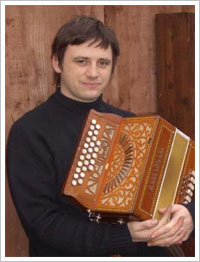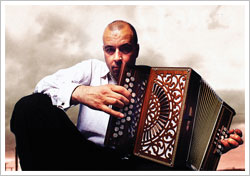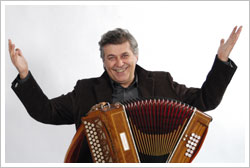|
What is a "Button Box?

|
|
Andy Cutting
|
Or, to give it it's posh name - Diatonic Button Accordion. The diatonic accordion (or melodeon) resembles a small piano accordion,
except where the piano-accordion has piano-style keys, the diatonic has one or more vertical rows of buttons - hence the title "button box". Each of these
rows of buttons plays a major scale in one key only - so to play in more than one key means that more than one row of buttons is required if all the notes
of the scale are to be available. Another characteristic is that each button plays two different notes - one when the bellows are closed, and another,
usually the next in the scale, when the bellows are opened. Similarly the bass buttons play one note or chord in one bellows direction and a different
one in the other.

|
|
Markku Leipisto
|
This system may appear a little strange at first sight, but it is what gives the instrument its character and is actually extremely logical.
It is the same system as used by the harmonica, Anglo system concertinas and other instruments such as the Bandoneon and Chemnitzer.
Although it limits the keys the 'box can play in, it keeps the physical size of the instrument down, and allows for very fast playing of arpeggios and
short scales - just the kind of thing found in a lot of traditional music.
A Brief History.
The diatonic accordion was developed in Germany in the middle years of the 19th century, taking on pretty much its modern form in the 1890's.
The development of a range of harmonica-type instruments and the concertina from the 1820s onwards clearly played a part in the development of the button
box, which became one of the most popular instruments in the world in the early 20th century.

|
|
Riccardo Tesi
|
The early instruments had only one row of buttons on the treble (right hand) side, and two bass buttons or levers, giving two bass note/chord
combinations - one when the bellows were pushed closed and another when they were pulled open. By the 1900s instruments with more than one row of treble
buttons appeared, giving access to a wider range of keys, and the bass accompaniment was also expanded by the addition of more buttons. By the 1920s,
instruments with up to five rows on the treble side, and a piano-accordion style bass system had appeared. Early boxes were fragile, with brass reeds
which went out of tune easily and a mechanism prone to breaking. They were however quite cheap, which led to huge numbers being produced in Germany and
Italy, and sold around the world.
During the 1930's a new, stronger version was developed with steel reeds and a stronger and more reliable mechanism. Since then there have been
refinements to the design and improved reliability and tonal quality, but no change in the basic design or system.
More information at http://users.skynet.be/jan.doumen/BAND/INDEX.HTM
|

